Difference between revisions of "Weapon leather"
| (16 intermediate revisions by one user not shown) | |||
| Line 9: | Line 9: | ||
| − | + | ==Military leather - Leather and weapons== | |
| + | Leather often appears in connection with military and weapons. It was used as armour, as part of the uniform ([[leather belt|belts]], [[Leather belt#Leather straps|straps]], [[Leather boots|boots]]), as holsters for rifles and pistols or as a knife blade. For centuries, leather was an important material for transporting weapons and ammunition, and was part of many uniforms. Even cannon barrels were made from [[parchment|dried skin]]. | ||
| + | |||
| + | |||
| + | ==Leather in military history== | ||
| + | The use of leather in military history has a long and important tradition. The material leather has proven to be extremely useful to protect soldiers in various wars and conflicts and improve their combat skills. | ||
| + | |||
| + | * Protection: Leather has been used in the manufacture of armor and protective gear since ancient times. Leather armor and armor have been developed over the centuries to protect the body from stabs, cuts and blows. Leather was also used for [[Leather hat#Leather helmet|helmets]], [[leather shoes|shoes]] and [[leather gloves|gloves]] to provide extra protection for the body parts. | ||
| + | * Toughness and Durability: Leather is a [[leather quality|tough and durable]] material that can withstand the rigors of war. It is resistant to wear, tear and abrasion, making it ideal for use in military equipment. [[Leather boots]], [[leather belt|belts]] and [[leather straps|straps]] were essential parts of soldiers' uniforms to keep their equipment secure and allow freedom of movement. | ||
| + | * Flexibility and freedom of movement: Leather is a flexible material that can adapt well to the shape of the body. This allowed soldiers to move freely and carry out their duties effectively. For example, [[leather gloves]] offered a good grip and tactile feedback when handling weapons and other gear. | ||
| + | * Insulation and Comfort: Leather also has [[leather quality|insulating properties]] that allowed soldiers to operate in different climatic conditions. It could retain heat and protect the body from cold. In addition, leather offered a degree of comfort by reducing friction and chafing, which was particularly beneficial during long marches or long engagements. | ||
| + | * Symbolism and Identification: Leather also played an important role in military symbolism and identification. In rank order in particular, certain leather accessories or insignia were used to denote rank or affiliation with a particular unit. | ||
| + | |||
| + | Overall, leather is of great importance in military history. It was not only a practical material for soldiers' protection and functionality, but also a symbol of strength, discipline and military identity. Leather still plays a role in military equipment and uniforms to this day, even though modern materials are increasingly being used. | ||
| + | |||
| + | |||
| + | ==Pistol holster - Rifle scabbard - rifle case== | ||
| + | The history of using leather in holsters goes back a long way. In the 17th century, the first leather holsters were crafted to securely store pistols and rifles during transport. Back then, holsters were often simple leather pouches attached to [[Leather belt|belts]]. | ||
| + | |||
| + | The main reason for using leather in holsters lies in its advantageous properties. Leather is [[leather quality|durable, resistant, sturdy]], and [[Flammability and fire retardancy of leather|heat-resistant]], making it an ideal material for protecting firearms. It provides a certain level of cushioning and safeguards the weapon from impacts, scratches, and other damages. At the same time, the soft material enables smooth drawing and reholstering of the firearm. Leather can be [[Formed leather|formed]] to fit the contours of the weapon, and it produces no loud noises, which is crucial for stealthy approaches. | ||
| + | |||
| + | Over time, holsters have been further developed and tailored to the specific needs of users. In the 19th century, leather holsters gained popularity, especially with the rise of revolvers and standardized service pistols. Leather holsters became standard equipment in many armies and police units. | ||
| + | |||
| + | In the 20th century, holsters with special features were developed to facilitate weapon access. Snap fasteners, buttons, or [[Leather belt|straps]] were added to securely hold the weapon in place while allowing quick access. | ||
| − | |||
<p align=center> | <p align=center> | ||
| − | [[bild:Holster-Pistole-01.jpg| | + | [[bild:Holster-Pistole-01.jpg|500px]] |
| − | + | ||
</p> | </p> | ||
<p align=center> | <p align=center> | ||
| − | '' | + | [[bild:Holster-Pistole-02.jpg|500px]] |
| + | </p> | ||
| + | <p align=center> | ||
| + | ''Pistol holsters have always been made of leather.''<br></p> | ||
<p> </p> | <p> </p> | ||
<p align=center> | <p align=center> | ||
| − | [[bild:Harley-1942-Gewehr.jpg| | + | [[bild:Harley-1942-Gewehr.jpg|500px]] |
| − | [[bild:Lederholster-01.jpg| | + | </p> |
| + | <p align=center> | ||
| + | [[bild:Lederholster-01.jpg|500px]] | ||
| + | </p> | ||
| + | <p align=center> | ||
| + | ''Rifle scabbard on a Harley from 1942. - Pistol holster from [https://www.facebook.com/sele.selestudio?fref=ts Selestudio].''<br></p> | ||
| + | <p> </p> | ||
| + | |||
| + | <p align=center> | ||
| + | [[bild:Rifle-case-leather-01.jpg|500px]] | ||
| + | </p> | ||
| + | <p align=center> | ||
| + | [[bild:Rifle-case-leather-02.jpg|500px]] | ||
</p> | </p> | ||
<p align=center> | <p align=center> | ||
| − | '' | + | ''Old [[Leather luggage|rifle case]].''<br></p> |
<p> </p> | <p> </p> | ||
| − | == | + | ==Patron belt== |
| − | + | Like [[leather belt|belts]] in general, patron belts are mostly made of leather. | |
<p align=center> | <p align=center> | ||
| − | [[bild:Patronengürtel-01.jpg| | + | [[bild:Patronengürtel-01.jpg|500px]] |
| − | + | ||
</p> | </p> | ||
<p align=center> | <p align=center> | ||
| − | ''[[ | + | [[bild:Patronengürtel-02.jpg|500px]] |
| + | </p> | ||
| + | <p align=center> | ||
| + | ''[[leather belt|Patron belts]] made of leather.''<br></p> | ||
<p> </p> | <p> </p> | ||
| Line 45: | Line 83: | ||
</p> | </p> | ||
<p align=center> | <p align=center> | ||
| − | ''[[ | + | ''[[Leather belt]] pouches for ammunition etc.''<br></p> |
<p> </p> | <p> </p> | ||
| − | == | + | ==Knife sheaths - Sword sheaths - Saber sheaths== |
| − | + | Sharp cutting edges of knives, rapiers, swords or sabers are often kept or transported in leather sheaths. The main function of a leather sheath is to securely store and protect the blade. Leather provides a soft, padded surface that safeguards the cutting tool from impacts, scratches, and corrosion. Additionally, leather absorbs moisture, helping to prevent rust formation. The sheath also protects the user from injuries caused by the sharp blade and enables safe transportation of the tool. | |
| + | |||
| + | The use of leather for sheaths dates back to ancient times. In many cultures, early versions of knives, sabers, and swords were kept in leather covers. Over time, different styles and constructions of leather sheaths emerged to meet the specific requirements and traditions of various cultures. | ||
| + | |||
| + | During the Middle Ages, the art of leather sheath making reached its peak in Europe. Craftsmen crafted elaborately decorated sheaths often adorned with precious metals like gold or silver. These artistic leather sheaths served not only as protection for the blades but also as a status symbol for the owner. | ||
| Line 56: | Line 98: | ||
</p> | </p> | ||
<p align=center> | <p align=center> | ||
| − | '' | + | ''Beautiful leatherwork - knife sheath from [https://www.facebook.com/sele.selestudio?fref=ts Selestudio].''<br></p> |
<p> </p> | <p> </p> | ||
<p align=center> | <p align=center> | ||
| − | [[bild:Messerscheide-Leder-Afrika-01.jpg| | + | [[bild:Messerscheide-Leder-Afrika-01.jpg|500px]] |
| − | + | ||
</p> | </p> | ||
<p align=center> | <p align=center> | ||
| − | + | [[bild:Messerscheide-Leder-Afrika-02.jpg|500px]] | |
| + | </p> | ||
| + | <p align=center> | ||
| + | ''Knife and knife sheath from Africa, produced before 1950.''<br></p> | ||
<p> </p> | <p> </p> | ||
| Line 71: | Line 115: | ||
</p> | </p> | ||
<p align=center> | <p align=center> | ||
| − | '' | + | ''Knife sheath for a Damascus blade (of [http://damastmesser.com/ damastmesser.com]).''<br></p> |
<p> </p> | <p> </p> | ||
<p align=center> | <p align=center> | ||
| − | [[bild:Brasilien-Bonito-Messer-der-Pantaneiros-01.jpg| | + | [[bild:Brasilien-Bonito-Messer-der-Pantaneiros-01.jpg|500px]] |
| − | + | ||
</p> | </p> | ||
<p align=center> | <p align=center> | ||
| − | + | [[bild:Schafsfelll-Sattel-01.jpg|500px]] | |
| + | </p> | ||
| + | <p align=center> | ||
| + | ''The pantaneiros, the cowboys of the Pantanal in Brazil], wear their knives in knife sheaths made of [[vegetable-tanned leather]] pushed into the back of the trousers.''<br></p> | ||
<p> </p> | <p> </p> | ||
| Line 86: | Line 132: | ||
</p> | </p> | ||
<p align=center> | <p align=center> | ||
| − | '' | + | ''Knife sheath made of leather, knife handle made of [[Ostrich leather|nandu claw]].''<br></p> |
<p> </p> | <p> </p> | ||
| Line 93: | Line 139: | ||
</p> | </p> | ||
<p align=center> | <p align=center> | ||
| − | '' | + | ''Knife handle made of narwhal horn and knife sheath made of [[fish leather#Stingray leather|stingray leather]], of [http://www.hoffnungsthaler-messerwerkstatt.de/ www.hoffnungsthaler-messerwerkstatt.de].''<br></p> |
<p> </p> | <p> </p> | ||
| Line 100: | Line 146: | ||
</p> | </p> | ||
<p align=center> | <p align=center> | ||
| − | '' | + | ''Saber sheaths protect against injuries.''<br></p> |
<p> </p> | <p> </p> | ||
<p align=center> | <p align=center> | ||
| − | + | [[bild:Sable sheath pigskin 02.jpg|500px]] | |
</p> | </p> | ||
<p align=center> | <p align=center> | ||
| − | + | [[bild:Sable sheath pigskin 01.jpg|500px]] | |
</p> | </p> | ||
| + | <p align=center> | ||
| + | ''Approximately 200 years old saber sheath made of [[pig leather]] for the planters of the Dutch East India Company (photo [https://www.mw-blankwaffen.de/ www.mw-blankwaffen.de]).''<br></p> | ||
| + | <p> </p> | ||
| + | |||
| + | <p align=center> | ||
| + | <flashow>//www.youtube.com/v/2jlrQD8T3rQ&fs=1&color1=0x660000&color2=0x550000&border=1|width=500|height=281,25</flashow> | ||
| + | </p> | ||
| + | <p align=center> | ||
| + | ''A video about the handmade production process of a knife sheath and the [[leather workshop|tools]] needed for it.''</p> | ||
| − | == | + | ==Protective covers made of leather== |
<p align=center> | <p align=center> | ||
| Line 117: | Line 172: | ||
</p> | </p> | ||
<p align=center> | <p align=center> | ||
| − | '' | + | ''Axe sheath of leather (of [http://damastmesser.com/ damastmesser.com]).''<br></p> |
<p> </p> | <p> </p> | ||
| − | == | + | ==Sword handles made of leather== |
<p align=center> | <p align=center> | ||
| − | [[bild:Schwertgriff-01.jpg| | + | [[bild:Schwertgriff-01.jpg|500px]] |
| − | + | ||
</p> | </p> | ||
<p align=center> | <p align=center> | ||
| − | + | [[bild:Schwert-01.jpg|500px]] | |
| + | </p> | ||
| + | <p align=center> | ||
| + | ''Sword leather handle, right of [http://www.ledermanufaktur.com www.ledermanufaktur.com].''<br></p> | ||
<p> </p> | <p> </p> | ||
| − | + | The blade of this Japanese sword is about 450 years old. The interchangeable handle comes from the 18th or 19th century and has a rare Tensho handle winding. Below the wrapped [[leather strips]] is ([[fish leather#Stingray leather|stingray leather]]). [[fish leather#Stingray leather|Stingray leather]] stabilises the underlying wooden sub-structure. The replaceable handle is secured by a pin made of tusk. | |
<p align=center> | <p align=center> | ||
| − | [[bild:Schwert-Japan-01.jpg| | + | [[bild:Schwert-Japan-01.jpg|500px]] |
| − | [[bild:Schwert-Japan-02.jpg| | + | </p> |
| + | <p align=center> | ||
| + | [[bild:Schwert-Japan-02.jpg|500px]] | ||
</p> | </p> | ||
<p align=center> | <p align=center> | ||
| − | '' | + | ''Incredible filigree craftsmanship from Japan.''<br></p> |
<p> </p> | <p> </p> | ||
<p align=center> | <p align=center> | ||
| − | [[bild:Schwertgriff-Japan-Rochenleder-02.jpg| | + | [[bild:Schwertgriff-Japan-Rochenleder-02.jpg|500px]] |
| − | + | ||
</p> | </p> | ||
<p align=center> | <p align=center> | ||
| − | '' | + | [[bild:Schwertgriff-Japan-Rochenleder-03.jpg|500px]] |
| + | </p> | ||
| + | <p align=center> | ||
| + | ''Sword handle with [[fish leather#Stingray leather|stingray leather]] from Japan.''<br></p> | ||
<p> </p> | <p> </p> | ||
| Line 153: | Line 214: | ||
<p align=center> | <p align=center> | ||
| − | [[bild:Schutzhelm-Leder.jpg| | + | [[bild:Schutzhelm-Leder.jpg|500px]] |
| − | [[bild:Schutzweste-01.jpg| | + | </p> |
| + | <p align=center> | ||
| + | [[bild:Schutzweste-01.jpg|500px]] | ||
</p> | </p> | ||
<p align=center> | <p align=center> | ||
| − | ''[[ | + | ''[[Leather hat#Leather helmet|Leather helmet]]. - [[Leather clothing|Protective leather vest]].''<br></p> |
<p> </p> | <p> </p> | ||
| − | + | ==[[Bolas - Boleadoras]]== | |
| + | Bolas are thrown weapons originally developed by indigenous peoples in South America. They are mainly used in the countries of the southern region of the continent, such as Argentina, Chile, Uruguay and parts of Brazil. Bolas were originally used to hunt wild animals, particularly fugitive animals such as guanacos or rhea birds. The technique of bolashunting consisted of attaching one or more balls to a string and then throwing them at great speed onto the target's leg or wings to tie or throw it. | ||
| − | + | The bolas were traditionally made from natural materials that were available in the area. Stones, pebbles or metal balls were usually used as weights. They were shaped to have sufficient mass to increase throwing power. The cords were often made of [[Tendons|animal tendons]], such as the tendons of guanacos or cougars. These tendons were strong and flexible, and could be easily stretched and knotted to attach the balls, which were sheathed in [[leather]]. To throw the bolas, handles were used, usually made of wood or bone. They allowed the thrower to hold the bolas securely and hurl them with enough momentum. | |
| − | + | ||
| − | [[ | + | |
<p align=center> | <p align=center> | ||
| − | [[bild:Bolas-02.jpg| | + | [[bild:Bolas-02.jpg|500px]] |
| − | + | ||
</p> | </p> | ||
<p align=center> | <p align=center> | ||
| − | ''[[Bolas]] | + | [[bild:Bolas-01-Ledermuseum-Offenbach.jpg|500px]] |
| + | </p> | ||
| + | <p align=center> | ||
| + | ''[[Bolas - Boleadoras|Bolas]], right seen in the [[Leather museum|DLM - German Leather Museum in Offenbach]].''<br></p> | ||
<p> </p> | <p> </p> | ||
| − | == | + | ==Leather shields== |
| − | In | + | In times when shields were used in wars, they were often leather-covered or made of leather. |
<p align=center> | <p align=center> | ||
| − | [[bild:Pergament-Schild-01.jpg| | + | [[bild:Pergament-Schild-01.jpg|500px]] |
| − | + | ||
</p> | </p> | ||
<p align=center> | <p align=center> | ||
| − | '' | + | [[bild:Schild-Punzieren-01-Ledermuseum-Offenbach.jpg|500px]] |
| + | </p> | ||
| + | <p align=center> | ||
| + | ''With [[parchment]] covered shield. - Motives on [[Carving leather|carved]] leather shield.''<br></p> | ||
<p> </p> | <p> </p> | ||
<p align=center> | <p align=center> | ||
| − | [[bild:Selestudio-Lederwerkstatt-01.jpg| | + | [[bild:Selestudio-Lederwerkstatt-01.jpg|500px]] |
| − | [[bild:Selestudio-Lederschild-01.jpg| | + | </p> |
| + | <p align=center> | ||
| + | [[bild:Selestudio-Lederschild-01.jpg|500px]] | ||
| + | </p> | ||
| + | <p align=center> | ||
| + | ''Production of a leather shield in the [[leather workshop]] of [https://www.facebook.com/sele.selestudio?fref=ts Selestudio].''<br></p> | ||
| + | <p> </p> | ||
| + | |||
| + | ==Leather Fly Swatter== | ||
| + | In a broader sense, a fly swatter is also a weapon made of leather, but in this case it is intended for flying insects. | ||
| + | |||
| + | |||
| + | <p align=center> | ||
| + | [[bild:Fly-swatter-01.jpg|500px]] | ||
</p> | </p> | ||
<p align=center> | <p align=center> | ||
| − | '' | + | ''A fly swatter made of [[vegetable-tanned leather]].''<br></p> |
<p> </p> | <p> </p> | ||
Latest revision as of 16:56, 17 July 2023
Contents
- 1 Military leather - Leather and weapons
- 2 Leather in military history
- 3 Pistol holster - Rifle scabbard - rifle case
- 4 Patron belt
- 5 Knife sheaths - Sword sheaths - Saber sheaths
- 6 Protective covers made of leather
- 7 Sword handles made of leather
- 8 Protective clothing
- 9 Bolas - Boleadoras
- 10 Leather shields
- 11 Leather Fly Swatter
- 12 Additional information
Military leather - Leather and weapons
Leather often appears in connection with military and weapons. It was used as armour, as part of the uniform (belts, straps, boots), as holsters for rifles and pistols or as a knife blade. For centuries, leather was an important material for transporting weapons and ammunition, and was part of many uniforms. Even cannon barrels were made from dried skin.
Leather in military history
The use of leather in military history has a long and important tradition. The material leather has proven to be extremely useful to protect soldiers in various wars and conflicts and improve their combat skills.
- Protection: Leather has been used in the manufacture of armor and protective gear since ancient times. Leather armor and armor have been developed over the centuries to protect the body from stabs, cuts and blows. Leather was also used for helmets, shoes and gloves to provide extra protection for the body parts.
- Toughness and Durability: Leather is a tough and durable material that can withstand the rigors of war. It is resistant to wear, tear and abrasion, making it ideal for use in military equipment. Leather boots, belts and straps were essential parts of soldiers' uniforms to keep their equipment secure and allow freedom of movement.
- Flexibility and freedom of movement: Leather is a flexible material that can adapt well to the shape of the body. This allowed soldiers to move freely and carry out their duties effectively. For example, leather gloves offered a good grip and tactile feedback when handling weapons and other gear.
- Insulation and Comfort: Leather also has insulating properties that allowed soldiers to operate in different climatic conditions. It could retain heat and protect the body from cold. In addition, leather offered a degree of comfort by reducing friction and chafing, which was particularly beneficial during long marches or long engagements.
- Symbolism and Identification: Leather also played an important role in military symbolism and identification. In rank order in particular, certain leather accessories or insignia were used to denote rank or affiliation with a particular unit.
Overall, leather is of great importance in military history. It was not only a practical material for soldiers' protection and functionality, but also a symbol of strength, discipline and military identity. Leather still plays a role in military equipment and uniforms to this day, even though modern materials are increasingly being used.
Pistol holster - Rifle scabbard - rifle case
The history of using leather in holsters goes back a long way. In the 17th century, the first leather holsters were crafted to securely store pistols and rifles during transport. Back then, holsters were often simple leather pouches attached to belts.
The main reason for using leather in holsters lies in its advantageous properties. Leather is durable, resistant, sturdy, and heat-resistant, making it an ideal material for protecting firearms. It provides a certain level of cushioning and safeguards the weapon from impacts, scratches, and other damages. At the same time, the soft material enables smooth drawing and reholstering of the firearm. Leather can be formed to fit the contours of the weapon, and it produces no loud noises, which is crucial for stealthy approaches.
Over time, holsters have been further developed and tailored to the specific needs of users. In the 19th century, leather holsters gained popularity, especially with the rise of revolvers and standardized service pistols. Leather holsters became standard equipment in many armies and police units.
In the 20th century, holsters with special features were developed to facilitate weapon access. Snap fasteners, buttons, or straps were added to securely hold the weapon in place while allowing quick access.
Pistol holsters have always been made of leather.
Rifle scabbard on a Harley from 1942. - Pistol holster from Selestudio.
Old rifle case.
Patron belt
Like belts in general, patron belts are mostly made of leather.
Patron belts made of leather.
Leather belt pouches for ammunition etc.
Knife sheaths - Sword sheaths - Saber sheaths
Sharp cutting edges of knives, rapiers, swords or sabers are often kept or transported in leather sheaths. The main function of a leather sheath is to securely store and protect the blade. Leather provides a soft, padded surface that safeguards the cutting tool from impacts, scratches, and corrosion. Additionally, leather absorbs moisture, helping to prevent rust formation. The sheath also protects the user from injuries caused by the sharp blade and enables safe transportation of the tool.
The use of leather for sheaths dates back to ancient times. In many cultures, early versions of knives, sabers, and swords were kept in leather covers. Over time, different styles and constructions of leather sheaths emerged to meet the specific requirements and traditions of various cultures.
During the Middle Ages, the art of leather sheath making reached its peak in Europe. Craftsmen crafted elaborately decorated sheaths often adorned with precious metals like gold or silver. These artistic leather sheaths served not only as protection for the blades but also as a status symbol for the owner.
Beautiful leatherwork - knife sheath from Selestudio.
Knife and knife sheath from Africa, produced before 1950.
Knife sheath for a Damascus blade (of damastmesser.com).
The pantaneiros, the cowboys of the Pantanal in Brazil], wear their knives in knife sheaths made of vegetable-tanned leather pushed into the back of the trousers.
Knife sheath made of leather, knife handle made of nandu claw.
Knife handle made of narwhal horn and knife sheath made of stingray leather, of www.hoffnungsthaler-messerwerkstatt.de.
Saber sheaths protect against injuries.
Approximately 200 years old saber sheath made of pig leather for the planters of the Dutch East India Company (photo www.mw-blankwaffen.de).
A video about the handmade production process of a knife sheath and the tools needed for it.
Protective covers made of leather
Axe sheath of leather (of damastmesser.com).
Sword handles made of leather
Sword leather handle, right of www.ledermanufaktur.com.
The blade of this Japanese sword is about 450 years old. The interchangeable handle comes from the 18th or 19th century and has a rare Tensho handle winding. Below the wrapped leather strips is (stingray leather). Stingray leather stabilises the underlying wooden sub-structure. The replaceable handle is secured by a pin made of tusk.
Incredible filigree craftsmanship from Japan.
Sword handle with stingray leather from Japan.
Protective clothing
Protective clothing made of leather.
Leather helmet. - Protective leather vest.
Bolas - Boleadoras
Bolas are thrown weapons originally developed by indigenous peoples in South America. They are mainly used in the countries of the southern region of the continent, such as Argentina, Chile, Uruguay and parts of Brazil. Bolas were originally used to hunt wild animals, particularly fugitive animals such as guanacos or rhea birds. The technique of bolashunting consisted of attaching one or more balls to a string and then throwing them at great speed onto the target's leg or wings to tie or throw it.
The bolas were traditionally made from natural materials that were available in the area. Stones, pebbles or metal balls were usually used as weights. They were shaped to have sufficient mass to increase throwing power. The cords were often made of animal tendons, such as the tendons of guanacos or cougars. These tendons were strong and flexible, and could be easily stretched and knotted to attach the balls, which were sheathed in leather. To throw the bolas, handles were used, usually made of wood or bone. They allowed the thrower to hold the bolas securely and hurl them with enough momentum.
Bolas, right seen in the DLM - German Leather Museum in Offenbach.
Leather shields
In times when shields were used in wars, they were often leather-covered or made of leather.
With parchment covered shield. - Motives on carved leather shield.
Production of a leather shield in the leather workshop of Selestudio.
Leather Fly Swatter
In a broader sense, a fly swatter is also a weapon made of leather, but in this case it is intended for flying insects.
A fly swatter made of vegetable-tanned leather.
Additional information












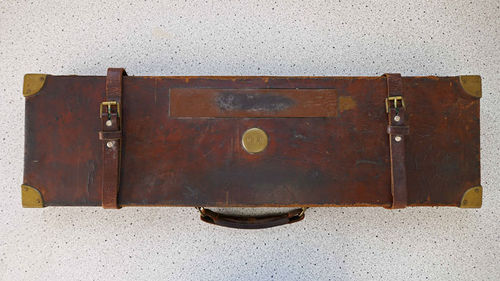
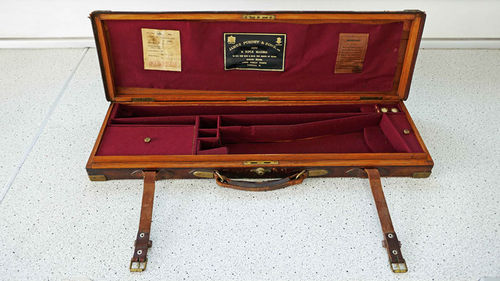
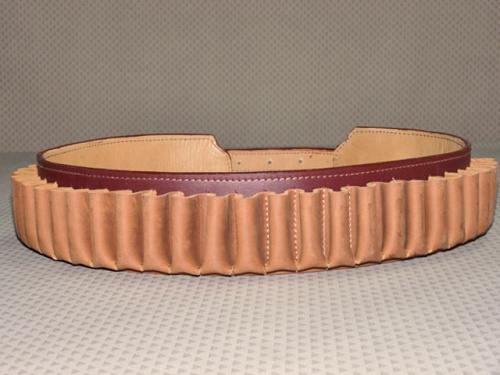

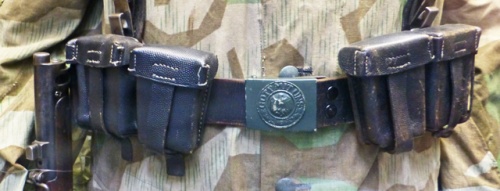












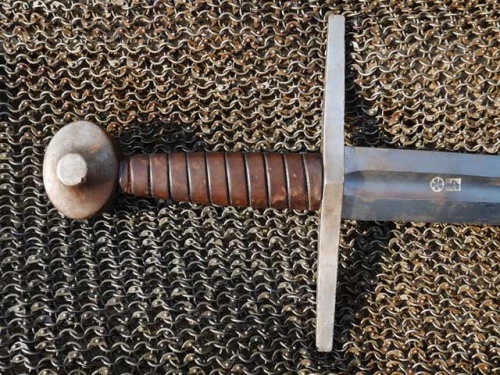

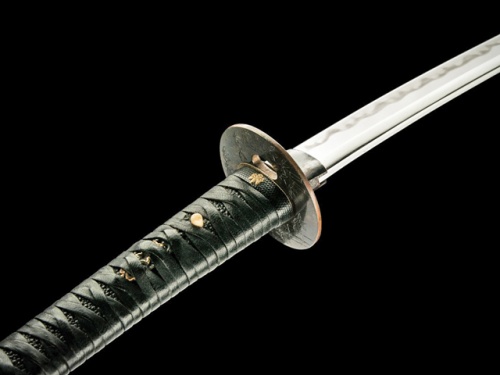


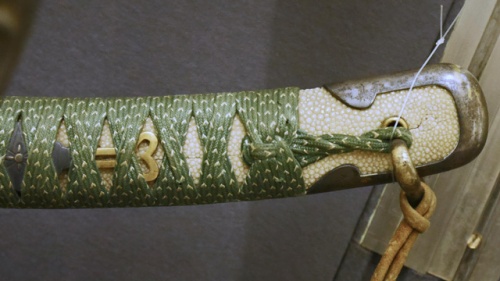
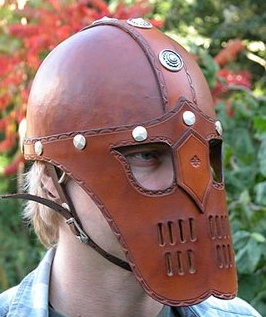

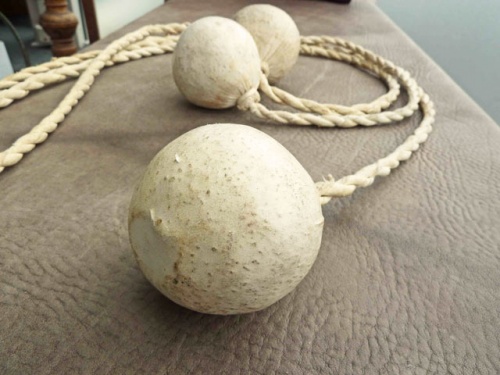







 a kotori web solution
a kotori web solution